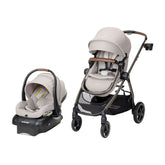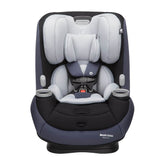Gas in Babies and Toddlers: What Causes It and How to Help

Updated 26 Dec 2024
Too much gas in the abdomen can cause a lot of discomfort in babies and toddlers – a distressing situation for caregivers, to say the least. Gas buildup is common in little ones, particularly newborns. The good news is that most children will find relief in a number of effective home remedies and treatments.
In some cases, your little one may be experiencing more than simple gassiness. If they cry for extended periods, have diarrhea or foul-smelling bowel movements, have trouble sleeping or feeding, and are frequently fussy, these could be signs of colic or a food intolerance. Consult your pediatrician if you suspect this may be the case. For many babies, though, who seem otherwise content and are feeding well, occasional gas trouble is simply a normal part of development. Here’s how to help a baby with gas and avoid some of the common causes.
What Causes Excessive Gas in Babies?
There are several triggers you may want to examine if your baby seems to periodically experience gas pain.
The speed of the milk flow
Whether it’s formula or breastmilk, the speed of the milk flow can affect their digestion. If it’s too fast, your baby may be gulping and swallowing large amounts of air which can lead to excess gas. A flow that’s too slow could have your baby sucking in more air in an effort to get more milk. This is why burping a baby after feeding is so important.
For nursing parents, try to express some breast milk before you put your baby to the breast, which should make the flow slower and allow your baby to drink without taking in so much air. Bottle-feeding parents may want to consider bottles or nipples that allow them to regulate the milk flow.
The way they latch
In addition to the speed of the milk flow, an infant’s latch must be correct on the bottle or breast, or they may end up swallowing excess air while feeding. If you suspect this may be the case, a lactation consultant can observe your baby’s latch and help determine what may be contributing to gas.
What they’re eating
The composition of your breastmilk or formula may or may not be affecting your baby’s gassiness, so it’s a good idea to consult with healthcare professionals before making any adjustments to their diet or yours.
For formula-fed babies: While it may seem enticing to switch to a different formula at the first indication of gas pain, making a change isn’t always necessary. Consult your pediatrician or a dietician who specializes in infants before making the switch. They may be able to offer other suggestions to improve your infant’s symptoms. If they do recommend making a change, opt for a gentle, sensitive, or “comfort” formula. These formulas offer a particular sugar and/or protein combination for babies who have difficulty tolerating standard formulas. For instance, some formulas are made of partially-digested cow’s milk protein which may aid in reduced gas production.
For nursing babies: In the past, nursing parents were sometimes advised to avoid certain foods to improve gassiness in the babies. However, new research has shown that with the exception of infants who’ve been diagnosed with cow’s milk allergy (CMA) or other immune-related food allergies, the food in a breastfeeding parent's diet doesn't always influence a baby’s physical symptoms. For breastfed babies, the nursing parent should strive to consume a varied, nutritious diet. If your breastfed baby is experiencing gas pain, talk to a healthcare provider or lactation consultant before eliminating certain foods from your diet. Unnecessarily restricting your diet while breastfeeding may affect your energy levels, milk production, and overall mental health.

What Causes Excessive Gas in Toddlers?
A toddler's diet is usually a big factor in their gas pain or indigestion. Certain foods and beverages are common culprits. Not drinking sufficient water can also trigger gas pain. Staying hydrated can help ease constipation that frequently accompanies abdominal discomfort. Here are a few other factors that may contribute to gas pain in toddlers.
- An immature digestive system. Your little one’s body is still growing and may not have fully developed enough to absorb certain foods well. Thus, the poorly digested remains end up fermenting in their colon causing gas, cramps, and diarrhea.
- Not sitting down during mealtimes. Not only does running around increase your toddler’s risk of choking, but it can also increase the odds of them getting gassy! An active, playing child tends to eat fast and take gulping swallows, increasing the amount of air in their system.
- Gum. Chewing gum increases their chances of swallowing extra air, and the artificial sweeteners used in many gums are difficult for young children to digest.
- Screen distractions. A child who’s preoccupied with television or video games while eating may miss their body’s cues that they’re full and end up overeating which leads to gas.
- Underlying issues. While periodic episodes of gas pain are normal in toddlers, chronic gassiness may be a sign of underlying problems. Lactose intolerance, irritable bowel syndrome (IBS), malabsorption, and celiac disease can all trigger gas as well as other digestive issues.
The good news is that older children are usually more adept at describing their accompanying symptoms, such as bloating, diarrhea, and abdominal pain. They may also be able to identify a connection between their physical symptoms and certain foods, like milk, fruits, or vegetables.

How to Ret Rid of Gas Fast: Gas Relief Remedies for Babies and Toddlers
There are a number of remedies for occasional gas pain in babies and toddlers. While prevention is the best option, there are a number of home remedies that can help your child feel more comfortable. Here are a few effective ways to improve symptoms.
Treating Gas Pain in Babies
Helping a baby with gas usually starts with a gentle tummy massage. Place your infant on their back and rub their belly in a clockwise pattern to help ease the gas out. Carefully holding their ankles and bicycling their legs may also help. Lying on the tummy may be the best position for a baby with gas in some cases. This position naturally applies pressure to the abdomen, facilitating the movement of gas.
Gas pain may seem more common at night, as gas builds up in the intestines during the day. Wondering how to help a baby with gas at night? If moving around doesn’t seem to help your little one much, you may want to try infant simethicone drops, a popular over-the-counter medicine for gas. Some parents also swear by gripe water, an over-the-counter liquid supplement of sodium bicarbonate and herbs. Always consult your pediatrician before administering any medication, herbal or otherwise, marketed as a treatment for baby gas.
Treating Gas Pain in Toddlers
Staying away from foods that cause painful gas in the first place is typically the most effective treatment for toddlers. Talk to your child’s doctor or dietician before restricting their diet. After you’ve got the green light from your healthcare provider, you may want to consider reducing gas-producing veggies, caffeine and carbonated beverages, fatty foods, artificial sweeteners, and juices. As your child develops, their body will be able to tolerate a larger variety of foods. For now, try to occasionally re-introduce gas-inducing foods in small amounts.
Additionally, encourage your little one to sip from a water bottle frequently during the day. In general, children ages 1 to 3 years need approximately 4 cups of beverages (32 ounces) per day. Make sure they get plenty of physical activity during the day to facilitate gas movement. If they’re experiencing gas pain at night, have them sip water and get up and walk around a bit to move gas through their system.
Finally, urge your child to sit down at the table with you during mealtimes. Make sure they chew their food well and take their time while eating. Eating too fast can cause them to swallow excess air. Limit distractions by turning off all screens and focusing on eating. Let them know that they’ll have playtime after they’re done eating.









